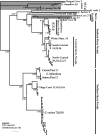Evolutionary diversification of cryophilic Grylloblatta species (Grylloblattodea: Grylloblattidae) in alpine habitats of California
- PMID: 20525203
- PMCID: PMC2898686
- DOI: 10.1186/1471-2148-10-163
Evolutionary diversification of cryophilic Grylloblatta species (Grylloblattodea: Grylloblattidae) in alpine habitats of California
Abstract
Background: Climate in alpine habitats has undergone extreme variation during Pliocene and Pleistocene epochs, resulting in repeated expansion and contraction of alpine glaciers. Many cold-adapted alpine species have responded to these climatic changes with long-distance range shifts. These species typically exhibit shallow genetic differentiation over a large geographical area. In contrast, poorly dispersing organisms often form species complexes within mountain ranges, such as the California endemic ice-crawlers (Grylloblattodea: Grylloblattidae: Grylloblatta). The diversification pattern of poorly dispersing species might provide more information on the localized effects of historical climate change, the importance of particular climatic events, as well as the history of dispersal. Here we use multi-locus genetic data to examine the phylogenetic relationships and geographic pattern of diversification in California Grylloblatta.
Results: Our analysis reveals a pattern of deep genetic subdivision among geographically isolated populations of Grylloblatta in California. Alpine populations diverged from low elevation populations and subsequently diversified. Using a Bayesian relaxed clock model and both uncalibrated and calibrated measurements of time to most recent common ancestor, we reconstruct the temporal diversification of alpine Grylloblatta populations. Based on calibrated relaxed clock estimates, evolutionary diversification of Grylloblatta occurred during the Pliocene-Pleistocene epochs, with an initial dispersal into California during the Pliocene and species diversification in alpine clades during the middle Pleistocene epoch.
Conclusions: Grylloblatta species exhibit a high degree of genetic subdivision in California with well defined geographic structure. Distinct glacial refugia can be inferred within the Sierra Nevada, corresponding to major, glaciated drainage basins. Low elevation populations are sister to alpine populations, suggesting alpine populations may track expanding glacial ice sheets and diversify as a result of multiple glacial advances. Based on relaxed-clock molecular dating, the temporal diversification of Grylloblatta provides evidence for the role of a climate-driven species pump in alpine species during the Pleistocene epoch.
Figures




Similar articles
-
Conserved and narrow temperature limits in alpine insects: Thermal tolerance and supercooling points of the ice-crawlers, Grylloblatta (Insecta: Grylloblattodea: Grylloblattidae).J Insect Physiol. 2015 Jul;78:55-61. doi: 10.1016/j.jinsphys.2015.04.014. Epub 2015 May 5. J Insect Physiol. 2015. PMID: 25956197
-
Colliding fragment islands transport independent lineages of endemic rock-crawlers (Grylloblattodea: Grylloblattidae) in the Japanese archipelago.Mol Phylogenet Evol. 2013 Mar;66(3):915-27. doi: 10.1016/j.ympev.2012.11.022. Epub 2012 Dec 6. Mol Phylogenet Evol. 2013. PMID: 23220515
-
Diversification of the Alpine chipmunk, Tamias alpinus, an alpine endemic of the Sierra Nevada, California.BMC Evol Biol. 2014 Feb 23;14(1):34. doi: 10.1186/1471-2148-14-34. BMC Evol Biol. 2014. PMID: 24559294 Free PMC article.
-
Evaluating signatures of glacial refugia for North Atlantic benthic marine taxa.Ecology. 2008 Nov;89(11 Suppl):S108-22. doi: 10.1890/08-0257.1. Ecology. 2008. PMID: 19097488 Review.
-
Decades-long phylogeographic issues: complex historical processes and ecological factors on genetic structure of alpine plants in the Japanese Archipelago.J Plant Res. 2022 Mar;135(2):191-201. doi: 10.1007/s10265-022-01377-w. Epub 2022 Feb 15. J Plant Res. 2022. PMID: 35166981 Free PMC article. Review.
Cited by
-
GenGIS 2: geospatial analysis of traditional and genetic biodiversity, with new gradient algorithms and an extensible plugin framework.PLoS One. 2013 Jul 29;8(7):e69885. doi: 10.1371/journal.pone.0069885. Print 2013. PLoS One. 2013. PMID: 23922841 Free PMC article.
-
Environmental and Biogeographic Drivers behind Alpine Plant Thermal Tolerance and Genetic Variation.Plants (Basel). 2024 May 4;13(9):1271. doi: 10.3390/plants13091271. Plants (Basel). 2024. PMID: 38732486 Free PMC article.
-
Testing models of refugial isolation, colonization and population connectivity in two species of montane salamanders.Heredity (Edinb). 2017 Oct;119(4):265-274. doi: 10.1038/hdy.2017.31. Epub 2017 Jun 21. Heredity (Edinb). 2017. PMID: 28635966 Free PMC article.
-
Hybridization in East African swarm-raiding army ants.Front Zool. 2011 Aug 22;8:20. doi: 10.1186/1742-9994-8-20. Front Zool. 2011. PMID: 21859477 Free PMC article.
-
Descriptions of a new genus and a new species, Grylloprimevala jilina (Grylloblattidae) from China.Ecol Evol. 2023 Jan 19;13(1):e9750. doi: 10.1002/ece3.9750. eCollection 2023 Jan. Ecol Evol. 2023. PMID: 36699568 Free PMC article.
References
-
- Kaufman DS, Porter SC, Gillespie AR. In: The Quaternary Period in the United States, 1. Gillespie AR, Porter SC, Atwater BF, editor. Vol. 1. Amsterdam, The Netherlands: Elsevier; 2004. Quaternary alpine glaciation in Alaska, the Pacific Northwest, Sierra Nevada, and Hawaii; pp. 77–103. [Rose J (Series Editor): Developments in Quaternary Science]
-
- Ehlers J, Gibbard PL. Quaternary Glaciations. Extent and Chronology: Part I Europe. Den Haag: Elsevier; 2004.
-
- Thompson RS, Anderson KH. Biomes of western North America at 18,000, 6000 and 0 C-14 yr BP reconstructed from pollen and packrat midden data. Journal of Biogeography. 2000;27:555–584. doi: 10.1046/j.1365-2699.2000.00427.x. - DOI
-
- Frenzel B. History of flora and vegetation during the Quaternary North America. Progress in Botany. 2005;66:409–440. full_text.
-
- Chabot BF, Billings WD. Origins and ecology of the Sierran alpine flora and vegetation. Ecological Monographs. 1972;42:163–199. doi: 10.2307/1942262. - DOI
Publication types
MeSH terms
Substances
LinkOut - more resources
Full Text Sources
Molecular Biology Databases

